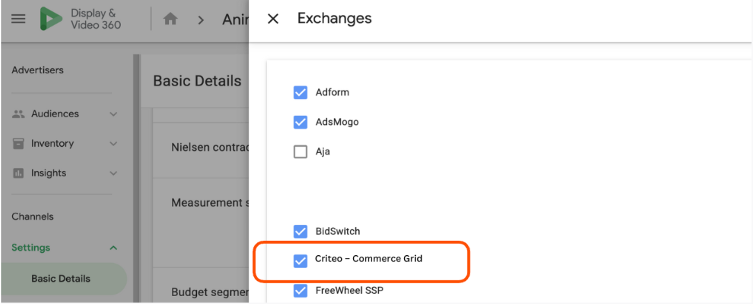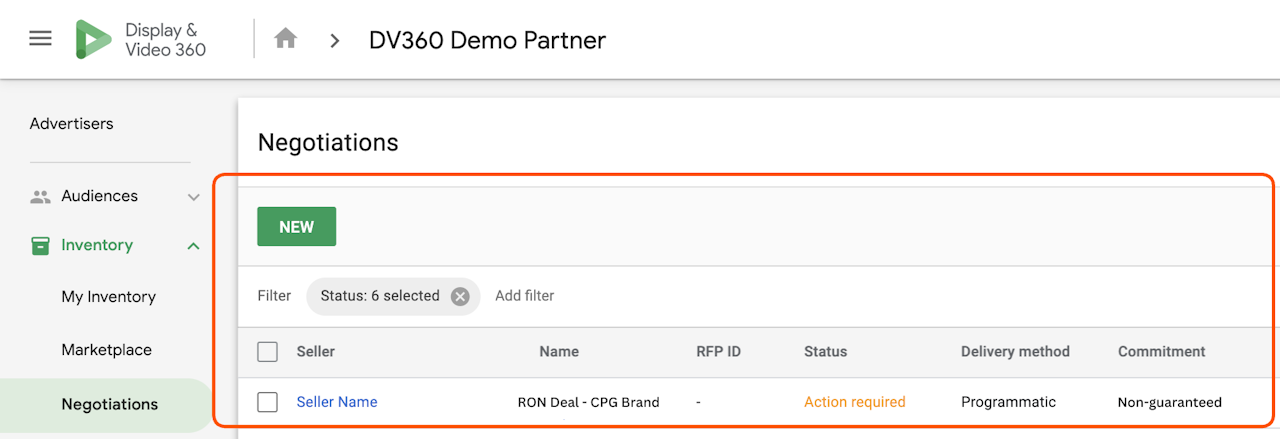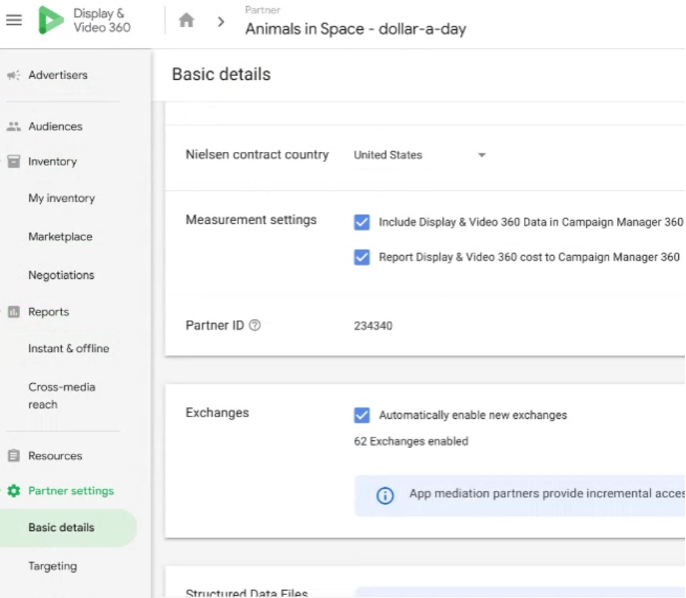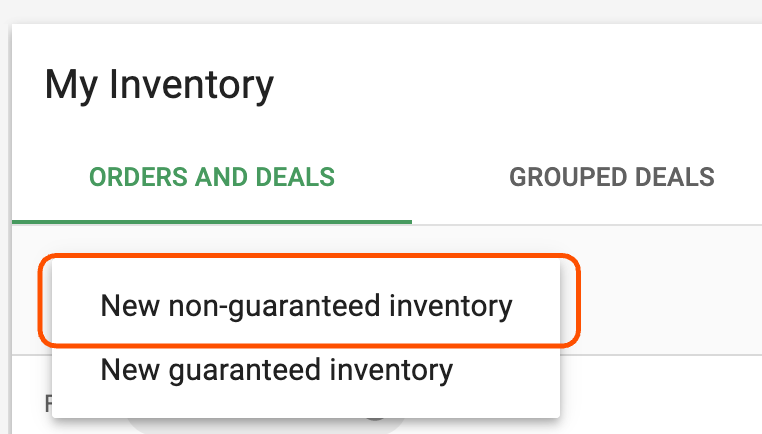



Overview
Commerce Grid has created this guide to help target Commerce Grid inventory using DV360 as their DSP.
Please note that platforms can and will change regularly. We will do our best to update this guide as needed. Wherever possible, we've provided links to DV360 documentation.
We recommend that if buyers are having issues, or if they need help using the DV360 platform, their first point of outreach should be the DV360 team.

Open Trading
This section explains how to target Commerce Grid (formerly The MediaGrid and Criteo SSP) as an inventory source within the DV360 UI.
To set up Commerce Grid SSP targeting in DV360, the buyer needs to target Criteo – Commerce Grid as a source in Supply Management settings on ad set creation.
To include or exclude other SSPs / Exchanges, click on Include / Exclude Supply.
Select Criteo – Commerce Grid from the available supply inventory
On the modal, you can see the excluded supplies on the right-hand side. If these are grayed out, it means that the buyer's organization has blocked them on the organization level, and they can not be included unless the organization settings are adjusted.
Click OK when you are done.
Additionally, buyers can adjust their DV360 settings to enable Criteo – Commerce Grid as a default supply source.
Option 1: Auto-opt all new exchanges |
|---|
|
Option 2: Enable Criteo – Commerce Grid individually |
If you haven't automatically enabled all new exchanges, you'd need to enable our exchange manually:
|

Deals Trading
This section explains how to set up and target Commerce Grid deals within the DV360 UI.
Commerce Grid's integration with the Display Video 360 (DV360) Seller API automatically synchronizes the deals created in Commerce Grid with the Google DV360 system. This enables a more seamless deal transaction between Commerce Grid publishers and curators, and DV360 buyers.
Below, we have outlined both automatic deal sync and manual deal setups in case the buyer's DV360 account is not enabled for Deal Sync.
Deal Sync Acceptance
Once a seller's deal is successfully synced to the Display Video 360 (DV360) systems, buyers should follow the below steps to accept the deal and start bidding on it.
Navigate to Negotiations to find the deals that can be accepted are listed under Negotiations. The buyer should look for the status Action required for the deal.
Click on the name of the proposed deal and click ACCEPT to finalize the proposed deal.
Click Save & Close or Save & Assign Line Items
After you import a Deal, review the respective campaign(s) and line items to ensure you’ve unselected ‘Public Inventory’ and use only the Deals and Packages as an inventory source to target your line items to specific private deals
Best Practices for DV360 Deal Sync
Deals must be set up with DV360 partner IDs. This deal synchronizing process does not support member ID deals.
Once a partner ID is selected for a deal, it cannot be changed in a subsequent update.
Deals synchronize every hour between Commerce Grid and DV360.
New deals are uploaded up to 1 hour after being created.
Updates to existing deals are uploaded up to 1 hour after it is created (depending on when the last sync script ran).
Buyer acceptance statuses are synchronized every hour.
Manual Deal Setup Acceptance
In DV360, the buyer should create a new Commerce Grid deal
Go to Inventory > Negotiations.
Choose Click the Add New button at the top right and select Non-guaranteed inventory
Select Import negotiation.
Choose exchange > Criteo - Commerce Grid.
Enter the deal ID or order ID/Marketplace ID. This ID is a unique identifier generated by the exchange or inventory seller. If you don’t know the deal ID, contact the seller.
Create Deal and fill in the following Deal Information fields.
Name - Give the deal a name.
ID - Use the provided Criteo – Commerce Grid DealID - usually in the form GRID-xxxx
Exchange - Select Criteo - Commerce Grid
Seller Name - Can be left blank
Inventory Format - Select Display or Video depending on your needs
Creative Requirements - For Display, choose relevant sizes. For Video, choose max video duration. Recommended maximum = 120 seconds
Rate Type - Select CPM Floor
Rate - Enter 0
Start Date - Enter the Start Date for the deal
End Date - Recommended to be left blank for always-on deals.
Advertiser - Select all advertisers that should have access to the Deal
Select Import. After you import a negotiation into DV360, copy + paste it into the respective campaign(s).
Click Save & Close or Save & Assign Line Items
Add Deal to Line Item
Now that the buyer has accepted the deal, it must be assigned to a line item.
To assign non-guaranteed inventory to existing line items:
Locate the deal in the Action Required section and select Action > Assign to an existing line item.
In the menu that appears on the right select the following:
Advertiser
Campaign
Insertion order
Line item(s)
Click Assign when you are done.
To assign non-guaranteed inventory to new line items:
Locate the deal in the Action Required section and select Action > Assign to new line item.
In the following page, enter the below information for your line item:
Name for your line item. Additionally, you can create your line item as a Draft if you don't want it to be immediately eligible to serve once you've saved it here. If you do want it to serve as soon as its start date has occurred, create the line item as Active.
Your line item's targeting.
Your line item's flight dates. For display and video line items, you can use real-time triggers to control your line item's flight.
Your Budget and Pacing settings. DV360 can automatically adjust your line item's budget if you've turned on automatic budget allocation for the line item's insertion order.
Your bid strategy.
The line item's frequency cap.
The creatives you want to use with this line item. A line item won't be able to serve until one or more creatives assigned to the line item is approved.
Your method for conversion tracking.
Review the inventory sources to ensure you’ve unselected ‘Public Inventory’ and use only the Deals and Packages as an inventory source to target your line items to specific private deals
Click Assign when you are done.
Deal Troubleshooting
How do I know a deal successfully uploaded to DV360 systems?
You can confirm this with the DV360 buyer by asking if they can see the deal in the negotiations page of the DV360 UI.
How do I know if a buyer accepted the deal in the DV360 UI?
Ask the DV360 buyer to confirm they have accepted the deal in the DV360 UI. We are working to display the DV360 buyer acceptance status in the UI and plan to release the feature in future iterations of this product.
What deal information is uploaded to DV360 systems via API?
The following details are shared with DV360 APIs:
Table 1. | ||
|
|
|
What will happen to existing DV360 deals that were created before enablement of deal sync?
Changes to existing deals created prior to enablement of DV360 deal sync will not automatically be uploaded to DV360 APIs. You will need to work with the buyer to manually update the deal objects in the DV360 UI, per the existing workflow.
Will updates to existing DV360 deals that were created before deal sync was enabled automatically update?
No, deals created prior to the enablement of DV360 deal sync on your account will not automatically update. You will need to work with the DV360 buyer to manually update the deal in the DV360 UI.
If I created a deal with DV360 post enablement of Deal sync and then updated the deal details, will they automatically update in DV360 systems?
Yes, deals created post DV360 deal sync enablement will have automatic deal updates. Changes you make to updatable fields (ex. start date, end date, price) will be automatically uploaded to DV360 systems. Once the changes are uploaded, this will trigger a change to the buyer status to "pending". You will need to ask the DV360 buyer to re-accept the deal in the DV360 UI.
What are things I cannot change with DV360 deals once they are created?
The following fields cannot be changed in DV360 systems after a deal is uploaded:
Deal ID
Deal Type
Auction Type
Currency
Can I change a buyer for a deal once it has been uploaded to DV360 systems?
Seller cannot remove buyers or seat IDs from a deal once it has been uploaded to DV360 systems.
If a DV360 buyer manually creates a deal first in DV360 UI using the deal ID, and then the deal with the same deal ID gets uploaded to DV360 via the deal sync process, how will DV360 systems handle it?
There are a few ways DV360 systems will react:
If the deal details of the deal created via API match the manually created deal, then the deal created via API is automatically matched with the manually created deal and will be accepted.
If the deal details of the deal created via API does not match the manually created deal, the buyer will be asked to re-accept the deal. Prior to re-acceptance, the deal created manually will continue to deliver based on old terms. Accepting the new deal will override the manually created deal.
If the deal type of the deal created via API upload differs from the manually created deal, the API call will fail. For example, if the manually created deal is a non-reserved deal, the API call will fail if you create a reserved deal via API.
Once a deal is uploaded to DV360 systems via the deal sync process, buyers will not be able to use that same deal ID to manually create a deal in the DV360 UI.
What are some ways for DV360 buyers to find the deal in the DV360 UI so they can accept it?
Buyers can find the deal through a few identifying factors in the Negotiations screen of the DV360 UI:
Filter for deals "pending action" to find deals that require the buyer's acceptance.
Search for deals using the seller name,
Search for deals using the deal name, which will be the name submitted in the Commerce Grid platform.
Can a seller pick and chose which DV360 buyers to automatically sync deals with?
That is not a feature that will be supported. Deal sync with DV360 is designed to automate deal sync for ALL DV360 buyers when sellers submit deals to their Seat IDs.
I created a deal with DV360 member 1212, why did it not sync with DV360 systems?
Deals created with DV360 Xandr members will not be supported in deal sync with DV360 as DV360 APIs require the DV360 partner ID declared in the deal. Commerce Grid is unable to determine which partner IDs to associate with a member ID deal.



